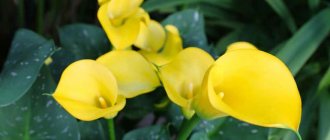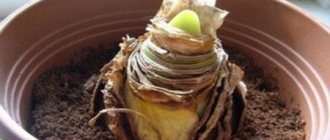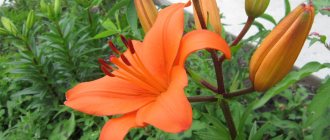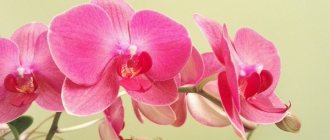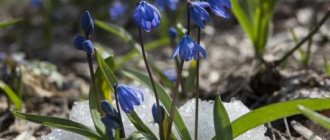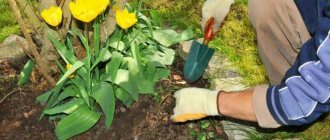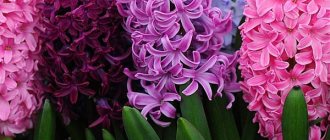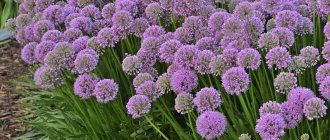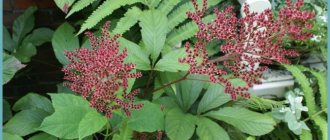The variety of spring bulbs is amazing, and the range increases every year. Flower growers are happy to plant them in order to admire the primroses in early spring and enjoy their aroma. But even experienced gardeners sometimes have questions about what to do when the hyacinths in the garden have faded.
How to choose hyacinth in a pot in a store
In early spring, stores begin to sell blooming hyacinths of various colors. If you decide to purchase a plant more than once, you need to choose the right hyacinth in a pot so that further forcing will be successful.
- Pay attention to the stem and peduncle, they should be erect.
- The plant bulb should be quite large - more than 5 cm in diameter.
- Look for any cracks, dents or pest damage on the bulb.
Feel free to take it if the plant looks healthy, with a dense bulb and bright leaves.
Features of hyacinth
The birthplace of the flower is considered to be the Middle East, North Africa, and the Mediterranean. But to make the plant population larger, Holland did a lot. For this reason, this country was given the name “hyacinth center”. The city of the Netherlands produced the most species. And the city of Haarlem sent many bulbs to different parts of the globe every year.
The 30 centimeter stem of the plant continues to the bottom. When the bush fades, the stem and foliage begin to dry out. But the upper leaf plate forms a bud in its corner. Then it will transform into a bulb, and next year it will bloom. Other plates can also form bulbs, but they will be weaker. Gardeners use these parts of the plant to grow new shrubs.
Inflorescences consist of double or simple buds. They can be purple, red, white, pink, yellow, blue and other colors. The shape of the brushes resembles a cone or cylinder, and the perianth resembles a bell-shaped funnel. The hyacinth fruit consists of three nests, each of which contains a pair of seeds with an air shell.
What to do with hyacinth after purchase
Flower growers disagree on whether it is worth replanting a blooming hyacinth just bought at the store.
Plants are sold in cramped pots, in which there is too little space for the bulb, not enough nutrient substrate, and the soil dries out too quickly. Therefore, if you see the need to replant a plant, you can carefully do it. To do this, thoroughly moisten the soil in which the plant is located and carefully transfer the bulb into a larger pot. Cover with soil, but do not bury the neck of the bulb.
After transplanting into a larger container, the plant not only looks better, but also becomes easier to care for. After flowering, it can be grown in the same pot.
Breeding history
The culture of hyacinths dates back more than two thousand years. The name of the fragrant flower comes from the name of one of the heroes of ancient Greek myths - a beautiful young man who was a close friend of the patron of the arts, the god of light Apollo. The “ancestors” of modern cultivars belong to the species “Oriental Hyacinth” (Hyacinthus orientalis). In the wild they grow in Greece, Dalmatia and Asia Minor.
In recent history, hyacinth cultivation began in Turkey and Greece in the 15th century. Over the next century, the flower migrated to Italy and then to the Netherlands. The efforts of Dutch breeders resulted in the creation of more than 2,000 varieties of plants, distinguished by the highest decorative properties.
In the photo - Hyacinthus orientalis, which served as the initial form for the creation of all modern cultivars
These flowers came to the territory of our country in the first half of the 18th century. For a long time, planting material was exclusively imported. The development of domestic varieties was started by specialists from the Sukhumi nursery, founded in 1898. Russian varieties were valued by European gardeners for the high quality of their bulbs, their ability to bloom early when forced, and to produce very large inflorescences. Already in Soviet times (in 1935), a floriculture state farm was organized near Adler, which was engaged in the propagation and sale of hyacinth bulbs on an industrial scale. At present, unfortunately, we are not conducting breeding work with the crop. Almost all planting material that goes on sale every year is imported from the Netherlands.
Flower care requirements
To obtain bright hyacinth flowers, it is necessary to take into account various features in its care.
Temperature and lighting
Hyacinth prefers bright, diffused light for at least 12 hours a day. Windows facing south and southeast are perfect for it. If the lighting is insufficient, the plant can be artificially illuminated. And so that the plant develops evenly and does not stretch one side towards the light, the pot with the bulb must be rotated regularly.
Comfortable temperature for hyacinth is 20–22 degrees. It should also be taken into account that sudden temperature changes, drafts and hot heating devices have a negative impact on the plant and can destroy it.
Watering and humidity at home
Hyacinth is a moisture-loving plant. Therefore, it is important to always keep the soil in the pot slightly moist. But the water should not stagnate, otherwise the plant may rot.
Watering is carried out with soft water, standing for 24 hours, at room temperature. When watering, it is important not to wet the bulb, leaf axils and buds. It is worth watering along the edge of the container, and if the pot is small, then you can water it in the pan.
Do not spray the plant, especially during flowering.
Soil and fertilizing
In specialized stores you can purchase a mixture for bulbous plants. To prepare the soil yourself, you need to mix in equal proportions:
- turf land;
- leaf soil;
- compost;
- sand;
- peat.
Perlite or vermiculite can be added to the hyacinth substrate; they retain moisture and promote soil aeration.
Preliminary tillage of the soil will avoid damage to the bulb by pests and reduce the risk of fungal diseases.
The soil in the pot is quickly depleted, so hyacinth needs regular feeding. During the growth period and at the budding stage, the plant is fed 2 times a month with fertilizer to stimulate flowering. Plants are fed from the very beginning of growth until the end of flowering. After the plant has flowered, it is fed with complex fertilizer.
Choosing a pot
A pot made of any material is suitable for hyacinth: plastic, clay, ceramic. The main thing is that it is deep, with a diameter 3–4 cm wider than the bulb. It is imperative to have drainage holes.
You can plant several types of hyacinths in one container, then during flowering you will have a beautiful and lush bouquet.
Soil requirements
Gardeners need to take into account some soil requirements for planting. Hyacinths love neutral soil. If the soil is alkaline, then acidify it a little, and if it is acidic, then add lime. For good development of hyacinths, loose and breathable soil is important. If necessary, you can add a loosening agent to the soil: river sand or vermiculite.
Monitor the fertility of the soil and provide the necessary nutrition to the hyacinths. Add superphosphate (70 g per m2), rotted manure (10 kg), and wood ash (200 g) to the soil. Dig up the area for planting the bulbs to a depth of 35-40 cm along with the listed fertilizer. Start preparing the land from the end of July - beginning of August.
The appearance of a peduncle and further care of the flowering plant
With proper care, the hyacinth quickly develops a peduncle. As soon as leaves begin to emerge from the bulb, developing buds can be seen.
Now, for good flower development, it is necessary to maintain a temperature of about 20 °C, protect from temperature changes and drafts. Twice a month, fertilize the plant with fertilizers to stimulate flowering and maintain the soil moisture necessary for the plant.
Growing in open ground
At the dacha, bulbous plants are given sunny areas. They do not like close groundwater and acidic soil. Select an area with neutral soil high in nutrients. However, organic fertilizers in the form of manure cannot be applied before planting.
On a note! For growing, you can set aside a corner under fruit trees. Early in the spring they will have enough light; later, the blossoming foliage will protect them from the wind.
The hyacinths have bloomed in the garden; what to do next is the main question for novice gardeners. During the growing season, nutrients are consumed from the bulb. At the end of the season, she needs time to recover. If there is no food, you may not see beautiful buds next year. After all, only one peduncle grows from each uterus.
Replanting after flowering
If the hyacinth was not transplanted into a new, larger pot immediately after purchase, then this must be done after the plant has flowered.
For transplantation you need:
- prepare the container;
- buy or prepare soil yourself;
- pour expanded clay onto the bottom of the pot and cover it with a layer of soil;
- Place the bulbs at 2/3 of the height, so that they do not touch the walls of the pot.
Important. The neck of the bulb must be above ground level, otherwise the plant may rot and die.
At what depth should hyacinths be planted in the fall?
Planting and caring for hyacinths does not cause any particular difficulties. It is quite important to determine the bulbs to the desired depth. The method that is used for any bulbous flowers is suitable here: the depth of the hole should be three times the length of the bulb itself. In light sandy soil you can make deeper holes. Heavy clay soils require shallower planting.
How to save a bulb after flowering
Further care for the bulb is simple; you just need to know a few rules:
- After the plant has flowered, you need to cut off the peduncle, leaving the leaves.
- If the plant is in a small pot, then it should be transferred to a larger container without deepening the neck of the bulb. This way the plant will continue its development and growth of children.
- It is best to keep the plant in a cool, bright place.
- Now you should water the hyacinth less abundantly and after the soil dries out.
- Around mid-May, the leaves will completely dry out and watering should be stopped.
- Next, you need to cut off the dried leaves, pull out the bulb and carefully clean it from the soil, remove dead scales.
- Dry the bulbs for 3 days.
- Store the bulbs in a dark, warm, well-ventilated area, in a cardboard box, paper bag or sawdust for about 2 months.
- A month before planting, the bulbs must be kept in a cool, damp room with a temperature no higher than +5 °C.
The hyacinth flowering phase lasts 2-3 weeks. The flowering period must necessarily be replaced by a dormant period; it is important to ensure a smooth transition between them. This will allow the bulb to rest and gain strength to continue to delight you with bright flowers.
How to properly care for winter?
In May, when the colorful inflorescences lose their charm, they are cut off. The green leaves are left until they turn completely yellow and wilt. Then they are removed. When the hyacinth has bloomed, the bulb collects the necessary materials for wintering and the next season through the leaves.
Hyacinth bulbs can be left in the ground and the soil can be fed with compost in the fall. If the flowers are to be moved to another location in the garden, the bulbs are dug up and stored in a dark, dry place during the summer. In October you can plant them in a new place.
Hyacinth is a frost-resistant plant, but the problem lies in fairly frequent weather changes and snowless periods. Before the arrival of winter, it is advisable to mulch the soil over the planted hyacinth bulbs, which will protect them from freezing (especially necessary for growing unstable varieties).
Answers to frequently asked questions
What to do with the flower after flowering?
Lush flowering of hyacinth takes a lot of energy from the bulb. In order for the plant to please you again with beautiful flowers and a wonderful aroma in a year, you need to give it a rest.
After flowering you need:
- cut off the peduncle;
- reduce watering;
- feed with complex fertilizer;
- wait for the leaves to dry, remove the bulb from the pot, clean it from the soil;
- dry the onion;
- put in a cool place.
In the fall, when the hyacinth bulb has rested, it is planted in open ground. The plant may not bloom in the spring, but this will prepare it for forcing next season.
Bulb requirements for healthy growth
A high-quality bulb is the key to beautiful flowering. When purchasing a potted hyacinth, carefully inspect the plant. The stem and peduncle should stand straight, without tilting, the leaves also look up.
For forcing in a pot, the bulb must meet certain requirements:
- choose a large onion with a diameter of more than 5 cm;
- the bulb should be elastic with clear scales;
- Make sure there is no damage or mold.
Experienced flower growers recommend purchasing hyacinth bulbs in trusted places and specialized stores.
Is it possible to adjust flowering to a certain moment?
Many gardeners also love hyacinth because it can be made to bloom at a certain time.
To determine the start date of forcing, it is necessary to count 3-3.5 months from the date on which flowering should occur.
During this time you need:
- place the bulb from a warm, dry place for 2–3 weeks in a dry but cool place, 5–10 °C;
- then the bulbs are planted in a pot, watered and left for 40–45 days in a cool, dark place;
- then placed for 10 days in a warmer - 15 ° C, but dark place.
At the end of forcing, the bulbs are transferred to normal conditions (on the windowsill). Over the course of a month, they will form a flower arrow with a bud.
If you need to get hyacinth to bloom by March 8, forcing should begin no later than mid-November.
When can you separate children?
After the faded bulbs have been removed from the pot, cleaned of dry leaves and soil, the children can be separated from them. If the children are firmly attached to the mother plant, they will easily detach before autumn planting, when the bulbs dry out.
Why does Hyacinth have a short peduncle and leaves fall out of the bulb?
There may be several reasons for this:
- non-compliance with temperature conditions during rest;
- insufficient watering;
- lack of fertilizing or irregularity of its implementation;
- aging of the bulb.
Is it possible to keep hyacinths in the bedroom?
If there is enough light in the room for this plant, and its rich aroma does not cause unpleasant sensations to the people who relax there, then there are no contraindications to placing hyacinth in the bedroom.
Some even believe that hyacinth charges people with good energy and has a beneficial effect on family relationships.
How to grow hacinth from babies and scales
Reproduction, most often, occurs in two ways: by bulbs formed on the mother's bulb - children and scales. There are other methods, but they are more difficult to implement.
Reproduction by bulbs - children
During the growing season, up to 5 small bulbs are formed near the main bulb.
Photo: Reproduction by children
How to plant hyacinth at home
Preparing the bulb
After the required dormant period, we select healthy, dense and large bulbs, more than 5 cm in diameter. To protect the plant from diseases, the bulbs are treated with one of the antifungal solutions.
Boarding time
Most often, they want to receive blooming hyacinth for a certain holiday, for example, March 8 or Valentine's Day. On average, after planting, the plant blooms within 3-3.5 months. Therefore, in order to receive flowers on time, you need to calculate the planting time in advance.
Soil preparation
Before planting plants, it is necessary to disinfect the soil. To do this, you can bake it in the oven for 30 minutes or pour it with a fungicide solution.
Landing
Hyacinth bulbs can be planted in an individual pot or in a flowerpot several at a time, at a distance of 2-3 cm from each other, to obtain a lush bouquet.
- It is necessary to add drainage to the bottom of the pot.
- Fill the pot 2/3 with soil.
- Plant the bulbs at half their height.
Rooting period
After planting, the plant must be watered without touching the bulbs and the pot must be placed in a cool, dark place at a temperature of about 5 degrees for the plant to root.
The final stage of forcing
After the sprout appears, about 5 cm high, the plant can be placed in a bright and warmer room.
When buds begin to form, the plant is transferred to a bright, warm room with a temperature of 20–22 °C.
Important. It is necessary to ensure a smooth change in temperature.
Forcing in water
Some gardeners prefer to force hyacinth without soil.
To do this, select a glass container with a neck of smaller diameter than the onion. Water is poured into the container so that the distance between the water and the onion is about 5 cm. The container with the onion is placed in a cool, dark place. And with the appearance of roots, they are transferred to a bright room.
Fertilizer must be added to the water once a month.
Planting dates and soil preparation
When to plant hyacinths is of interest to many gardeners. It is better to do this in the fall in the last week of September - the first week of October. Planting earlier or later will result in the death of the plant.
Daffodils planting and care in open ground
2 months before the expected date of planting hyacinthus bulbs, prepare a flower bed. The selected place is dug to a depth of at least 40 cm, organic fertilizers (for example, humus or compost), potash and phosphorus fertilizers are added.
Sand should be added to heavy soils; lime, chalk or ash should be added to highly acidic soils. The prepared bed is covered with dark film or boards. This measure will prevent the appearance of weeds in the flowerbed.
How to plant hyacinths in the garden in spring
In spring, hyacinth bulbs are rarely planted. Most often, store-bought hyacinths are used for planting in open ground in spring. These flowers should be planted following these steps:
- When the hyacinth fades, the peduncle is removed.
- The plant along with the earthen lump is taken out of the pot.
- A hole is made in the previously prepared soil to the depth of the pot.
- Sand is poured into the bottom of the hole as drainage.
- Place the hyacinth bulb together with a lump of earth in the hole and cover it with soil.
- Water the plant around, being careful not to wet the bulb itself.
Important! Preparing the land for planting purchased hyacinth should begin immediately after the snow melts. The dug up soil must have time to settle.
If there is a threat of spring frosts, the planted flowers are covered with non-woven material.
Rules for planting hyacinths in autumn
In autumn, hyacinths are planted in late September - early October. Prepare a flower bed for planting at least 10 days in advance. After the soil has settled, holes are made for each plant. Sand is poured into the bottom of the recess and the bulb is placed. A sand cushion no more than 1.5 cm thick is made around it. Fertile soil is poured on top.
Important! The depth of planting the bulbs should exceed their height by 3 times. The distance between the holes is made equal to the planting depth.
After planting in dry soil, the plants are watered. If the soil is moist, then watering is not needed. You can also plant tubers in a common bed, but in this case more sand will be needed. It is more expedient to make individual holes for planting plants in a large flower bed. When all the plants are planted, the flowerbed is mulched with peat, straw or sawdust.
It is important to determine exactly when to plant hyacinths in open ground. If planted early, the plant will germinate and the young shoot will freeze. If you delay planting in the garden plot, the tuber will not have time to take root and will die when frost sets in.
Propagation of hyacinths at home
Reproduction by children
During the time that the plant is in the soil after flowering, 2–3 children are formed on it. After the mother bulb is dried, the children are separated from it and sent on vacation with it.
In the fall, the children are planted in the ground. They will begin to bloom only after 3–4 years, when they reach the size of an adult plant.
Cuttings
During the period when the hyacinth began to form buds, you can prepare cuttings for its propagation. To do this, you need to select a leaf and cut it off at the very base of the bulb. The cut is treated with a disinfectant and growth-stimulating drug. Planted obliquely to a depth of about 3 cm in a container with substrate. Cover with film and keep in diffused light and room temperature. After about a month, 2–4 sprouts appear. When they grow a little, small bulbs are planted in a pot or greenhouse.
Cutting the bottom
This is one of the methods of artificial propagation of hyacinths, which produces a large number of children, more than 20 pieces.
To reproduce in this way you need:
- after the dormant period, choose the largest and healthiest bulbs;
- Use a sharp blade to cut the bottom and place the onion cut side up;
- at a temperature of 20–22 °C, after 2–3 months, babies form on the bulb;
- now the mother onion can be planted in a greenhouse;
- When the first shoots appear, you need to separate the children and plant them in separate pots or a common box.
Bulb dissection
A large, dense onion should be divided into 5–6 parts with a sharp knife. Separate each slice into scales. Treat sections with a disinfectant.
The scales are stored in plastic bags. In the first month at a temperature of +20–25 °C, in the second – +17–20 °C.
During this time, 1–2 bulbs form at the base of the scales.
This method can produce up to 50 seedlings from one mother bulb.
Types and varieties of hyacinths
The cultivars belong to 3 different species of bulbous plants in the Asparagus family. The distribution area extends from the Middle East to northeastern Iran.
- Hyacinth Litvinowii (Hyacinthus litwinowii) is found in Turkmenistan, in northern Iran. Grows up to 20-25 cm. The leaves are lanceolate, rather wide. The flowers are small and blue. Blooms in mid or late April.
- Transcaspian dwarf hyacinth (Hyacinthus transcaspicus). The plant is native to the mountainous region between Turkmenistan and western Iran. The perennial reaches a height of 15-20 cm. The leaves spread along the ground and are quite thick. The flowers of the species are elongated and pale blue in color. There are few flowers in the inflorescence - up to 10 pieces. Above the green fleshy leaves grow light blue or dark blue flowers, collected in a loose bunch (4-10 pieces).
- Eastern Hyacinth (Hyacinthus orientalis) - only this species grows well in our Central European climate. The place of origin is considered to be the Mediterranean region. Currently grown in Europe, USA, Russia, and other parts of the world.
Oriental hyacinth includes more than 100 different varieties. Small six-rayed hyacinth flowers, the number of which is up to 40, have different colors:
- white;
- light blue;
- soft pink;
- raspberry;
- yellow;
- peach;
- orange;
- salmon;
- bright red;
- purple.
Typically one bulb produces one inflorescence. Some varieties produce several flower shoots. There are varieties with individual flowers. All hyacinths have beautiful flowers and a unique aroma. Here are a few well-known varieties, broken down by color:
| Flower color | Varieties |
| white | "Snow Crystal" Snow Christal, "White Pearl" White Pearl, "Carnegie" Carnegie |
| pink | “Freestyler” Freestyler, “Pink Pearl” Pink Pearl, “Anna Marie” Anna Marie |
| light purple | “Anastasia”Anastasia, “Crystal Palace” Christal Palace, “Amethyst” Ametist |
| red | "Holly Hook" Holly Hook, "Jan Bos" Jan Bos |
| blue | "General Köhler" General Köhler, "Blue Jacket" Blue Jacket |
| salmon | “Prince of Love” Prince of Love, “Gypsy Queen” Gipsy Queen |
| yellow | "City of Haarlem" City of Haarlem, "Yellow Queen" Yellow Queen |
| orange | "Gypsy Queen" Gipsy Queen |
Diseases and pests
Like any plants, hyacinths are subject to various diseases or pest attacks.
Yellow bacterial rot
During this disease, the bulb liquefies. An unpleasant odor begins to emanate from it, and the plant stops growing. The onset of the disease can be recognized by the gray spots that appear on the leaves.
Parasitic blossom end rot
The disease is caused by pathogenic microorganisms found in contaminated soil. Small brown depressions appear on the flowers and leaves of the plant, the tips of the leaves become thinner and destroyed, and the roots rot.
Mosaic
Chaotically located elongated light green spots appear on the leaves and flowers. The affected areas begin to turn yellow and dry out. The plant slows down its growth and may die.
Gray rot
Most often it affects plants during the period of early growth. Yellow spots form on the plant, which gradually increase in size and become brown in color. The disease quickly affects the roots and the plant dies.
Pests
The main pests of hyacinths are aphids, spider mites, nematodes, flower flies and mole crickets. Plants become depleted, leaves turn yellow and wither, buds fall off. If pests are not noticed in time, they can destroy the plant.
Insecticides, which are sold at any garden store, help in controlling pests.
Orientation to the lunar calendar
The gardener's lunar calendar depends on the phases of the Moon and the Zodiac. It indicates favorable and unfavorable days for planting hyacinths in the fall. These dates are marked:
- September - from 3 to 7, from 18 to 23;
- October - 2-6, 18-20, 28-30.
The calendar also indicates dates when it is strictly not recommended to plant anything:
- during the full moon - September 9 and October 9;
- on the full moon - September 25, October 24.
Why is this necessary?
Hyacinth needs a transplant in two cases.
- After purchasing a potted plant. Hyacinths intended for forcing are kept in a special “transport” low-nutrient but loose soil that retains moisture for a long time.
The plant blooms due to the nutrients accumulated in the bulb.
To preserve such a hyacinth after flowering, the bulb is transplanted into a fertile substrate, giving it the opportunity to recover and produce offspring. If this is not done, the flower will die.
- After the foliage of garden plants wilts . For full flowering, bulbous primroses need to provide a period of rest, during which the bulbs will be at a constant temperature of +18 +22 degrees and low humidity. This period lasts 60 - 80 days. In a temperate climate, such conditions can only be ensured by digging flowers out of the soil.
On a note . Some gardeners replant garden hyacinths not annually, but once every 3-4 years, combining digging with separation of the resulting children. This is acceptable for unpretentious varieties and species of plants. Beautiful, modern capricious varieties and hybrids require annual digging with strict adherence to the parameters of the dormant period.
When and how is the onion removed for storage?
Withered leaves indicate the time of bulb removal. It must be dug out of open ground before the end of June. There is no need to wait for the leaves to dry completely, otherwise you may lose the babies and not find the location of the bulb itself.
Choose a dry day for digging, otherwise there will be a lot of soil on the bulbs and you will need to wash them with water. Using a flat bayonet shovel, they try to take the layer just below the level of the plants. The soil is thrown back where the flowers have already been dug up.
Bulbs with babies are selected from the discarded soil. The bottom of a plastic fruit box is lined with paper, and hyacinth bulbs are placed on it in one layer to dry. Varietal seedlings are distributed immediately into different boxes.
After flowering, the potted plant is immediately transferred, along with the still green leaves, into a larger pot. As soon as the leaves wither, remove the bulb for storage.
Personal experience: What NOT to do!
Several years ago I gave my mother, sister and myself a gift
